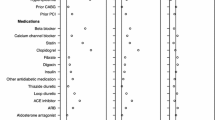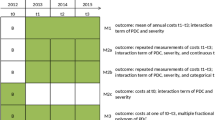Abstract
Background
Risk prediction models can be powerful tools to support clinical decision-making, to help targeting interventions, and, thus, to improve clinical and economic outcomes, provided that model performance is good and sensitivity and specificity are well balanced. Drug utilization as a potential risk factor for unplanned hospitalizations has recently emerged as a meaningful predictor variable in such models. Drug treatment is a rather unstable (i.e. time-dependent) phenomenon and most drug-induced events are concentration-dependent and therefore individual drug exposure will likely modulate the risk. This especially applies to longitudinal monitoring of appropriate drug treatment within claims data as another promising application for prediction models.
Methods and Results
To guide future research towards this direction, we firstly reviewed current risk prediction models for unplanned hospitalizations that explicitly included information on drug utilization and were surprised to find that these models rarely attempted to consider dose and frequent modulators of drug clearance such as interactions with co-medication or co-morbidities. As another example, they often presumed class effects where in fact, differences between active moieties were well established. In addition, the study designs and statistical risk analysis disregarded the fact that medication and risk modulators and, thus, adverse events can vary over time. In a simulation study, we therefore evaluated the potential benefit of time-dependent Cox models over standard binary regression approaches with a fixed follow-up period.
Conclusions
Longitudinal drug information could be utilized much more efficiently both by precisely estimating individual drug exposure and by applying more refined statistical methodology to account for time-dependent drug utilization patterns.


Similar content being viewed by others
References
Steyerberg EW (2009) Clinical prediction models—a practical approach to development, Validation, and updating. Springer Science + Business Media, LL. doi:10.1007/978-0-387-77244-8
Moons KG, Altman DG, Reitsma JB, Ioannidis JP, Macaskill P, Steyerberg EW, Vickers AJ, Ransohoff DF, Collins GS (2015) Transparent reporting of a multivariable prediction model for individual prognosis or diagnosis (TRIPOD): explanation and elaboration. Ann Intern Med 162(1):W1–73. doi:10.7326/M14-0698
Moons KG, Royston P, Vergouwe Y, Grobbee DE, Altman DG (2009) Prognosis and prognostic research: what, why, and how? BMJ 338:b375. doi:10.1136/bmj.b375
Hallas J, Gram LF, Grodum E, Damsbo N, Brosen K, Haghfelt T, Harvald B, Beck-Nielsen J, Worm J, Jensen KB et al (1992) Drug related admissions to medical wards: a population based survey. Br J Clin Pharmacol 33(1):61–68
Kansagara D, Englander H, Salanitro A, Kagen D, Theobald C, Freeman M, Kripalani S (2011) Risk prediction models for hospital readmission: a systematic review. JAMA 306(15):1688–1698. doi:10.1001/jama.2011.1515
Wallace E, Stuart E, Vaughan N, Bennett K, Fahey T, Smith SM (2014) Risk prediction models to predict emergency hospital admission in community-dwelling adults: a systematic review. Med Care 52(8):751–765. doi:10.1097/MLR.0000000000000171
Stevenson JM, Williams JL, Burnham TG, Prevost AT, Schiff R, Erskine SD, Davies JG (2014) Predicting adverse drug reactions in older adults; a systematic review of the risk prediction models. Clin Interv Aging 9:1581–1593. doi:10.2147/CIA.S65475
O’Mahony D, O’Sullivan D, Byrne S, O’Connor MN, Ryan C, Gallagher P (2014) STOPP/START criteria for potentially inappropriate prescribing in older people: version 2. Age Ageing. doi:10.1093/ageing/afu145
Schmiedl S, Szymanski J, Rottenkolber M, Drewelow B, Haase G, Hippius M, Reimann IR, Siegmund W, May K, Haack S, Hasford J, Thurmann PA, Deutsche P-S (2007) Analysis of hospital admissions associated with digitalis glycosides. Med Klin (Munich) 102(8):603–611. doi:10.1007/s00063-007-1064-x
Jonsson AK, Spigset O, Jacobsson I, Hagg S (2007) Cerebral haemorrhage induced by warfarin—the influence of drug-drug interactions. Pharmacoepidemiol Drug Saf 16(3):309–315. doi:10.1002/pds.1291
Schjerning Olsen AM, Gislason GH, McGettigan P, Fosbol E, Sorensen R, Hansen ML, Kober L, Torp-Pedersen C, Lamberts M (2015) Association of NSAID use with risk of bleeding and cardiovascular events in patients receiving antithrombotic therapy after myocardial infarction. JAMA 313(8):805–814. doi:10.1001/jama.2015.0809
Frishman WH, Horn J (2008) Statin-drug interactions: not a class effect. Cardiol Rev 16(4):205–212. doi:10.1097/CRD.0b013e31817532db
Billings J, Mijanovich T (2007) Improving the management of care for high-cost Medicaid patients. Health Aff (Millwood) 26(6):1643–1654. doi:10.1377/hlthaff.26.6.1643
Lewis GH (2010) “Impactibility models”: identifying the subgroup of high-risk patients most amenable to hospital-avoidance programs. Milbank Q 88(2):240–255. doi:10.1111/j.1468-0009.2010.00597.x
Weber C, Neeser K (2006) Using individualized predictive disease modeling to identify patients with the potential to benefit from a disease management program for diabetes mellitus. Dis Manag 9(4):242–256. doi:10.1089/dis.2006.9.242
Krause DS (2005) Economic effectiveness of disease management programs: a meta-analysis. Dis Manag 8(2):114–134. doi:10.1089/dis.2005.8.114
Roland M, Dusheiko M, Gravelle H, Parker S (2005) Follow up of people aged 65 and over with a history of emergency admissions: analysis of routine admission data. BMJ 330(7486):289–292. doi:10.1136/bmj.330.7486.289
Steyerberg EW, Moons KG, van der Windt DA, Hayden JA, Perel P, Schroter S, Riley RD, Hemingway H, Altman DG, Group P (2013) Prognosis research strategy (PROGRESS) 3: prognostic model research. PLoS Med 10(2) e1001381. doi:10.1371/journal.pmed.1001381
Hanley JA, McNeil BJ (1982) The meaning and use of the area under a receiver operating characteristic (ROC) curve. Radiology 143(1):29–36. doi:10.1148/radiology. 143.1.7063747
Louis DZ, Robeson M, McAna J, Maio V, Keith SW, Liu M, Gonnella JS, Grilli R (2014) Predicting risk of hospitalisation or death: a retrospective population-based analysis. BMJ Open 4(9) e005223. doi:10.1136/bmjopen-2014-005223
Billings J, Georghiou T, Blunt I, Bardsley M (2013) Choosing a model to predict hospital admission: an observational study of new variants of predictive models for case finding. BMJ Open 3(8) e003352. doi:10.1136/bmjopen-2013-003352
Chenore T, Pereira Gray DJ, Forrer J, Wright C, Evans PH (2013) Emergency hospital admissions for the elderly: insights from the Devon Predictive Model. J Public Health (Oxf) 35(4):616–623. doi:10.1093/pubmed/fdt009
NHS National Services Scotland (2013) Scottish patients at risk of readmission (SPARRA). Version 3 (2011). Available from: http://www.isdscotland.org/Health-Topics/Health-and-Social-Community-Care/SPARRA/2012-02-09-SPARRA-Version-3.pdf. Accessed: September 8, 2015
Donnan PT, Dorward DW, Mutch B, Morris AD (2008) Development and validation of a model for predicting emergency admissions over the next year (PEONY): a UK historical cohort study. Arch Intern Med 168(13):1416–1422. doi:10.1001/archinte.168.13.1416
Hippisley-Cox J, Coupland C (2013) Predicting risk of emergency admission to hospital using primary care data: derivation and validation of QAdmissions score. BMJ Open 3(8) e003482. doi:10.1136/bmjopen-2013-003482
Andersohn F, Walker J (2016) Characteristics and external validity of the German Health Risk Institute (HRI) Database. Pharmacoepidemiol Drug Saf 25(1):106–109. doi:10.1002/pds.3895
Ahlbom A, Alfredsson L (2005) Interaction: a word with two meanings creates confusion. Eur J Epidemiol 20(7):563–564
Meid AD, Heider D, Adler JB, Quinzler R, Brenner H, Gunster C, Konig HH, Haefeli WE (2016) Comparative evaluation of methods approximating drug prescription durations in claims data: modeling, simulation, and application to real data. Pharmacoepidemiol Drug Saf. doi:10.1002/pds.4091
Meid AD, Lampert A, Burnett A, Seidling HM, Haefeli WE (2015) The impact of pharmaceutical care interventions for medication underuse in older people: a systematic review and meta-analysis. Br J Clin Pharmacol 80(4):768–776. doi:10.1111/bcp.12657
Meid AD, Haefeli WE (2016) Age-dependent impact of medication underuse and strategies for improvement. Gerontology. doi:10.1159/000443477
Riley RD, Ahmed I, Ensor J, Takwoingi Y, Kirkham A, Morris RK, Noordzij JP, Deeks JJ (2015) Meta-analysis of test accuracy studies: an exploratory method for investigating the impact of missing thresholds. Syst Rev 4(1):12. doi:10.1186/2046-4053-4-12
Riley RD, Takwoingi Y, Trikalinos T, Guha A, Biswas A, Ensor J, Morris RK, Deeks JJ (2014) Meta-analysis of test accuracy studies with multiple and missing thresholds: a multivariate-normal model. J Biomet Biostat 5(3):196. doi:10.4172/2155-6180.1000196
Tibshirani R (1996) Regression shrinkage and selection via the lasso. J R Stat Soc Ser B Methodol 58(1):267–288. doi:10.2307/2346178
Acknowledgements
This work was supported in part by the German Federal Ministry of Education and Research (BMBF, Berlin, Germany) under Grant Number 01GY1320B and supported by Elsevier GmbH (Munich, Germany) under the project title “SmartCheck”.The authors would like to thank Richard Riley for the support on multivariate meta-analysis and the anonymous reviewers for stimulating ideas that substantially helped to improve the manuscript.
Contribution of the authors
ADM, AG, and WEH substantially contributed to the conception, design, analysis, and interpretation of the data of the study as well as writing of the manuscript. JW and US substantially contributed to the conception of the analyses and interpretation of the data and critically revised the manuscript. All authors had full access to study data and approved the final version before publication.
Author information
Authors and Affiliations
Corresponding author
Ethics declarations
Conflict of interest
The authors declare that they have no conflict of interest.
Electronic supplementary material
ESM 1
(PDF 1104 kb)
Rights and permissions
About this article
Cite this article
Meid, A.D., Groll, A., Schieborr, U. et al. How can we define and analyse drug exposure more precisely to improve the prediction of hospitalizations in longitudinal (claims) data?. Eur J Clin Pharmacol 73, 373–380 (2017). https://doi.org/10.1007/s00228-016-2184-0
Received:
Accepted:
Published:
Issue Date:
DOI: https://doi.org/10.1007/s00228-016-2184-0




